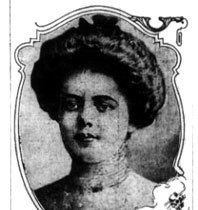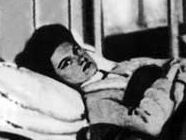Cause of death Pneumonia Occupation Cook Residence United States Name Mary Mallon | Other names Mary Brown Role Cook Ethnicity Irish | |
 | ||
Nationality Irish by birth; American citizen by naturalization after immigration Died November 11, 1938, North and South Brother Islands, New York, New York City, New York, United States Similar People Rob Sonic, Aesop Rock, George Soper, Gaetan Dugas | ||
Hail mary mallon plagues and bacon
Mary Mallon (September 23, 1869 – November 11, 1938), better known as Typhoid Mary, was the first person in the United States identified as an asymptomatic carrier of the pathogen associated with typhoid fever. She was presumed to have infected 51 people, three of whom died, over the course of her career as a cook. She was twice forcibly isolated by public health authorities and died after a total of nearly three decades in isolation.
Contents
- Hail mary mallon plagues and bacon
- Typhoid mary la vera storia di mary mallon la cuoca tifoidea
- Early life
- Career
- Investigation
- First quarantine 190710
- Release and second quarantine 191538
- Death
- Legacy
- In popular culture
- References

Typhoid mary la vera storia di mary mallon la cuoca tifoidea
Early life
Mary Mallon was born in 1869 in Cookstown, County Tyrone, in what is now Northern Ireland. She immigrated to the United States in 1883 at the age of 15. She lived with her aunt and uncle for a time and later found work as a cook for affluent families.
Career
From 1900 to 1907, Mallon worked as a cook in the New York City area for seven families. In 1900, she worked in Mamaroneck, New York, where, within two weeks of her employment, residents developed typhoid fever. In 1901, she moved to Manhattan, where members of the family for whom she worked developed fevers and diarrhea, and the laundress died. Mallon then went to work for a lawyer; she left after seven of the eight people in that household became ill.
In 1906, she took a position in Oyster Bay, Long Island, and within two weeks 10 of the 11 family members were hospitalized with typhoid. She changed jobs again, and similar occurrences happened in three more households. She worked as a cook for the family of a wealthy New York banker, Charles Henry Warren. When the Warrens rented a house in Oyster Bay for the summer of 1906, Mallon went along too. From August 27 to September 3, six of the 11 people in the family came down with typhoid fever. The disease at that time was "unusual" in Oyster Bay, according to three medical doctors who practiced there. Mallon was subsequently hired by other families, and outbreaks followed her.
Investigation
In late 1906, one family hired a typhoid researcher named George Soper to investigate. Soper published the results on June 15, 1907, in the Journal of the American Medical Association. He believed Mallon might be the source of the outbreak. He wrote:
"It was found that the family changed cooks on August 4. This was about three weeks before the typhoid epidemic broke out. She remained in the family only a short time, leaving about three weeks after the outbreak occurred. The cook was described as an Irish woman about 40 years of age, tall, heavy, single. She seemed to be in perfect health."
Soper discovered that a female Irish cook, who fit the physical description he was given, was involved in all of the outbreaks. He was unable to locate her because she generally left after an outbreak began, without giving a forwarding address. Soper learned of an active outbreak in a penthouse on Park Avenue, and discovered Mallon was the cook. Two of the household's servants were hospitalized, and the daughter of the family died of typhoid.
When Soper approached Mallon about her possible role in spreading typhoid, she adamantly rejected his request for urine and stool samples. Since Mallon refused to give samples, he decided to compile a five-year history of Mallon's employment. Soper found that of the eight families that hired Mallon as a cook, members of seven claimed to have contracted typhoid fever. On his next visit, he brought another doctor with him but again was turned away. During a later encounter when Mallon was herself hospitalized, he told her he would write a book and give her all the royalties. She angrily rejected his proposal and locked herself in the bathroom until he left.
First quarantine (1907–10)
The New York City Health Department finally sent physician Sara Josephine Baker to talk to Mallon. Baker stated "by that time she was convinced that the law was only persecuting her when she had done nothing wrong." A few days later, Baker arrived at Mallon's workplace with several police officers, who took her into custody.
Mallon attracted so much media attention that she was called "Typhoid Mary" in a 1908 issue of the Journal of the American Medical Association. Later, in a textbook that defined typhoid fever, she was again called "Typhoid Mary."
Mallon admitted poor hygiene, saying she did not understand the purpose of hand-washing because she did not pose a risk. In prison, she was forced to give stool and urine samples. Doctors found a significant nidus of typhoid bacteria in her gallbladder. Authorities suggested removing her gallbladder, but she refused as she did not believe she carried the disease. She was also unwilling to cease working as a cook.
The New York City Health Inspector determined her to be a carrier. Under sections 1169 and 1170 of the Greater New York Charter, Mallon was held in isolation for three years at a clinic located on North Brother Island.
Eventually, Eugene H. Porter, the New York State Commissioner of Health, decided that disease carriers should no longer be kept in isolation and that Mallon could be freed if she agreed to stop working as a cook and take reasonable steps to prevent transmitting typhoid to others. On February 19, 1910, Mallon agreed that she was "prepared to change her occupation (that of a cook), and would give assurance by affidavit that she would upon her release take such hygienic precautions as would protect those with whom she came in contact, from infection." She was released from quarantine and returned to the mainland.
Release and second quarantine (1915–38)
Upon her release, Mallon was given a job as a laundress, which paid less than cooking. After several unsuccessful years of working as a laundress, she changed her name to Mary Brown and returned to her former occupation despite having been explicitly instructed not to. For the next five years, she worked in a number of kitchens; wherever she worked, there were outbreaks of typhoid. However, she changed jobs frequently, and Soper was unable to find her.
In 1915, Mallon started another major outbreak, this time at Sloane Hospital for Women in New York City. 25 people were infected and two died. She again left, but the police were able to find and arrest her when she brought food to a friend on Long Island. After arresting her, public health authorities returned her to quarantine on North Brother Island on March 27, 1915. She was still unwilling to have her gallbladder removed. Mallon remained confined for the remainder of her life. She became a minor celebrity and was occasionally interviewed by the media. They were told not to accept even water from her. Later, she was allowed to work as a technician in the island's laboratory, washing bottles.
Death
Mallon spent the rest of her life in quarantine at the Riverside Hospital. Six years before her death, she was paralyzed by a stroke. On November 11, 1938, she died of pneumonia at age 69. An autopsy found evidence of live typhoid bacteria in her gallbladder. Mallon's body was cremated, and her ashes were buried at Saint Raymond's Cemetery in the Bronx.
Legacy
Among the infections Mallon caused, at least three deaths were attributed to her. However, because of her use of aliases and refusal to cooperate, the exact number is not known. Some have estimated that she may have caused 50 fatalities.
Mallon was the first asymptomatic typhoid carrier to be identified by medical science, and there was no policy providing guidelines for handling the situation. Some difficulties surrounding her case stemmed from Mallon's vehement denial of her possible role, as she refused to acknowledge any connection between her working as a cook and the typhoid cases. Mallon maintained that she was perfectly healthy, had never had typhoid fever, and could not be the source. Public-health authorities determined that permanent quarantine was the only way to prevent Mallon from causing significant future typhoid outbreaks.
Other healthy typhoid carriers identified in the first quarter of the 20th century include Tony Labella, an Italian immigrant, presumed to have caused over 100 cases (with five deaths); an Adirondack guide dubbed "Typhoid John", presumed to have infected 36 people (with two deaths); and Alphonse Cotils, a restaurateur and bakery owner.
Today, "Typhoid Mary" is a colloquial term for anyone who, knowingly or not, spreads disease or some other undesirable thing.
In August 2013, researchers at the Stanford University School of Medicine announced they were making breakthroughs in understanding the exact science behind asymptomatic carriers such as Mallon. The bacteria that cause typhoid may hide in macrophages, a type of immune cell.
Individuals can develop typhoid fever after ingesting food or water contaminated during handling by a human carrier. The human carrier may be a healthy person who has survived a previous episode of typhoid fever yet who continues to shed the associated bacteria, Salmonella typhi, in feces and urine. Washing hands with soap before touching or preparing food, washing dishes and utensils with soap and water, and only eating cooked food are all ways to reduce the risk of typhoid infection.
